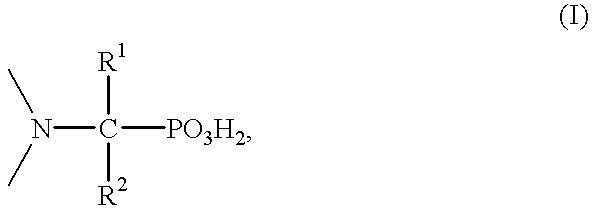Method for effecting solvent extraction of metal ions using hydrocarbon soluble aminomethylene phosphonic acid compounds
a technology of hydrocarbon soluble aminomethylene and phosphonic acid, which is applied in the direction of arsenic compounds, niobium compounds, antimony compounds, etc., can solve the problems of insufficient efficiency, uneconomical, and disadvantages of the above-mentioned process
- Summary
- Abstract
- Description
- Claims
- Application Information
AI Technical Summary
Problems solved by technology
Method used
Image
Examples
example 1
Reaction Product of di-2-ethylhexylamine with Phosphorous Acid and Formaldehyde
289.8 g (1.20 mol) of di-2-ethylhexylamine were initially charged and 118.1 g (1.44 mol) of phosphorous acid dissolved in 160 ml of water were added dropwise. Subsequently, 85.2 g of concentrated sulfuric acid which had been diluted with 75 ml of water were added. The mixture obtained was heated to about 100.degree. C. and 247 g (3.0 mol) of aqueous formaldehyde solution (36.5% strength) were added dropwise. The mixture was refluxed for 40 hours and the organic phase was then separated off and washed 3 times with 500 ml each time of water. Remaining water in the washed organic phase was removed in a water pump vacuum. Yield: 370 g of a yellow viscous oil (92% of theory); by-product: methyldi(2-ethylhexylamine); elemental analysis: P.sub.found 7.1%, N.sub.found 4.3%.
The following examples illustrate the use according to the present invention of aminomethylenephosphonic acid derivatives, but do not limit th...
examples 2 to 18
Extraction Tests
Solvent Extraction of Various Metals from Aqueous Solutions
Aqueous synthetic metal salt solutions containing 1 g / l of metal, together for (Fe.sup.3+, Cu.sup.2+, Zn.sup.2+, Al.sup.3+), (Mg.sup.2+, Ni.sup.2+, Co.sup.2+, Cd.sup.2+) and (Cr.sup.3+, Mn.sup.2+) or individually for V.sup.5+, Mo.sup.6+, Ga.sup.3+, Ge.sup.4+, Sn.sup.2+, As.sup.3+ and Bi.sup.3+ were prepared in a sulfate-containing medium (200 g / l of sulfuric acid), with the corresponding sulfates or oxides (reagent grade or analytical reagent) being used.
The aqueous phases (aq.) were intimately mixed for 30 minutes at room temperature (20-25.degree. C.) with the organic phases (org.) consisting of 15% (w / v) of extractant (Example 1) and 15% (w / v) of isodecanol in LK.sup.1), in an org. / aq. ratio of 1:1, with the appropriate pH being set by addition of sodium hydroxide solution. The pH was monitored and kept constant. The metal or the metals were extracted from the aqueous phase into the organic phase. After th...
PUM
| Property | Measurement | Unit |
|---|---|---|
| Percent by mass | aaaaa | aaaaa |
| Concentration | aaaaa | aaaaa |
| Concentration | aaaaa | aaaaa |
Abstract
Description
Claims
Application Information
 Login to View More
Login to View More - R&D
- Intellectual Property
- Life Sciences
- Materials
- Tech Scout
- Unparalleled Data Quality
- Higher Quality Content
- 60% Fewer Hallucinations
Browse by: Latest US Patents, China's latest patents, Technical Efficacy Thesaurus, Application Domain, Technology Topic, Popular Technical Reports.
© 2025 PatSnap. All rights reserved.Legal|Privacy policy|Modern Slavery Act Transparency Statement|Sitemap|About US| Contact US: help@patsnap.com



